If someone new to the conversation walked into the Yurok Tribe's first Missing and Murdered Indigenous People Symposium on Oct. 4 expecting an arm's-length policy discussion, they would have quickly realized their mistake.
They may have looked past the vendor booths designed to showcase Native makers, or the way the 300 seats were arranged around circular tables in the Arcata Community Center, clad with black tablecloths and regalia centerpieces to foster small group discussions. And they may have thought the catered lunch simply a sustenance break rather than an intentional opportunity for attendees to break bread. But within minutes of the program's start, it would have been impossible to miss the fact that the subject was intensely personal, having directly touched many in attendance.
"I come with a heavy heart today," said Norma Contreras, tribal chair of the La Jolla Band of Luiseño Indians, the first of more than a dozen tribal leaders who'd traveled to the symposium, to introduce herself. "My family member ... three years ago, we found one of my family members' body on the reservation."
As a tribal council member at the time, Contreras said she was forced to balance grieving and governing, a task all too familiar to many of her peers.
"This is a very, very sensitive thing for me," she said.
Moments later — after tribal leaders from as far south as Jamul Indian Village to the northern-most edge of the state introduced themselves — Yurok Councilmember Phillip Williams took the microphone.
"In 2017, Oct. 31, my daughter went missing. The next day, she was found and she was passed. And I went through a lot of pain," Williams said, his voice briefly cracking with emotion. "I apologize. That's how I became a tribal leader. Once I made it through that pain, I knew there was nothing — nothing — that could knock me down. The Creator made this path for me to be here. I was a little reluctant to come here and speak today because I don't really like to share my pain, but I believe this is the right forum. You know, I look at all the women in my family — my mother, my mother-in-law, my sisters, my aunties, my nieces — they've all been affected by violence. So I've done a lot of soul searching and the conclusion I've come to is we need to raise the value of an Indigenous life."
Williams' comments drew an ovation, with some in attendance already dabbing tears from their eyes. And thus began the symposium, a day-long event that featured three panel discussions with some of the state's foremost experts on various aspects of the MMIP epidemic. Tribal leaders and those working on the front lines of combating the myriad of issues associated with the crisis from throughout the state answered the Yurok Tribe's invitation. Also in attendance were hosts of tribal, state and county law enforcement officers, including a few of their federal counterparts, as well as tribal, county and federal prosecutors, and county, state and federal elected representatives.
Amid a crisis that has been metastasizing in plain view for decades, the all-hands-on-deck response to the Yurok Tribe's call was remarkable in and of itself.
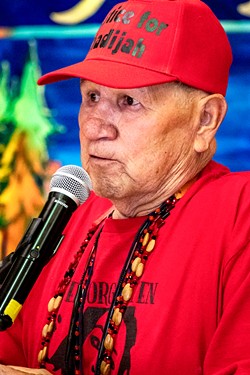
- Photo by Mark Larson
- Ronnie Hostler talks about his granddaughter, Kadijah Britton, a Wailaki member of the Round Valley Indian Tribes, who was reported missing in 2018, during a press conference after the symposium.
"No one tribe, no one advocate, no one individual can lead this effort," said Yurok Tribal Chair Joseph James amid his opening remarks, before thanking his tribal team, the event's sponsors, as well as tribal, state and federal leaders. "It's a good day today. Last night, we did a cultural sharing event last night, too, and it was good to dance and pray, to walk in the footsteps and seek guidance from the Creator, as we're all born and raised and taught from our parents and grandparents. ... It was good to share, it was good to eat with everyone last night. What we are want to get out of this summit here today is, as I've always said, awareness is great, awareness is needed, and we will continue to do that. But it's time for action."
'Made Safe'
It's perhaps fitting that the first question in a day full of them was about the epidemic's root causes and went to Abby Abinanti. A Yurok tribal member and the first Native to become a member of the California Bar Association, she has served as the Yurok Tribal Court's chief justice since 2008, instating a Yurok Wellness Court that has been heralded as an example of progressive, culturally relevant justice system.
"When you're talking about murdered and missing, that's a symptom and it's not a cause," Abinanti said. "And it comes from what's happening in our homelands and what's happening to our people."
Keeley Linton, who serves as executive director for the Strong Hearted Native Women's Coalition and has spent two decades working to reduce family violence, pointed out that it's important to remember MMIP isn't a new issue.
"This is an old problem of missing Indian women — it's been going on since the late 1800s," she said.
While it looks different today, the generational trauma and impacts of an attempted genocide continue to be felt in all facets of life. One of those is an almost institutionalized invisibility. Multiple panelists talked about how the need to remain out of sight — once a survival skill — has in many ways rendered Native people invisible to society at large, where they are frequently undercounted and ignored.
Blythe George knows this better than most. A Yurok tribal member, George is an assistant professor of sociology at the University of California at Merced who helped lead the Yurok Tribe's three-year To' Kee Skuy' Soo Ney-Wo-Chek' (I Will See You Again in a Good Way) project, which sought to quantify the MMIP epidemic and develop a blueprint for tribal responses.
"I often say, you don't know what you don't know," George said. "We can't hope to intervene in this crisis if we don't know where to start and, unfortunately, that's a great disparity with this issue. Unfortunately, many of us in this room, we are sometimes only one or two people removed from an active case. But when it comes to the great majority of Americans, they don't really have anywhere to start — they don't understand the problem, and getting data is such an important part of that. But right now, as the data stands, we have to take it all with a grain of salt."
George explained that demographic data often fails to properly count Native people, noting they are often listed incorrectly if they are "white passing" or have a Latinx-sounding last name. And even when counted correctly, George said the demographic data often isn't shared by law enforcement or other agencies. This makes it really difficult to track Native people and their outcomes through programs and institutions.
Multiple speakers talked of the frustration of trying to get data on the numbers of Native homicide victims or children in foster care, and being told there isn't any, only to later find they just weren't being properly counted.
But George stressed that even the limited data available shows an "alarming trend" that sees Native people victimized by violence at disproportionate rates — Native women even more so.
"As a Native woman, I tell my students I'm just as likely to die of homicide as of heart disease or diabetes," George said.
Panelists pointed to a complex web of causal factors, from high rates of generational trauma to intervention programs that aren't culturally informed. Native children end up in foster care at hugely disproportionate rates — they account for 35 to 40 percent of children in Humboldt County foster care, while Native people make up only 6.4 percent of the population, according to State Sen. Mike McGuire. Once there, those children experience disproportionately poor outcomes.
Raechel Ibarra, an Indigenous advocate and caseworker at a nonprofit law firm, pointed out that children frequently leave foster care placements, which can land them in juvenile hall, where services are limited and outcomes diminish, adding to the "foster care to MMIP pipeline." She also touched on the generational aspect of the problems, saying she doesn't "have a youth in foster care who doesn't have an incarcerated parent, and these parents have trauma."
"My personal opinion: I believe that youth in foster care are hunted because no one looks for them," Ibarra said. "They are the most vulnerable population because their identities have to be concealed. ... We only know about them because they're our sister's children, our mother's children or part of our communities."
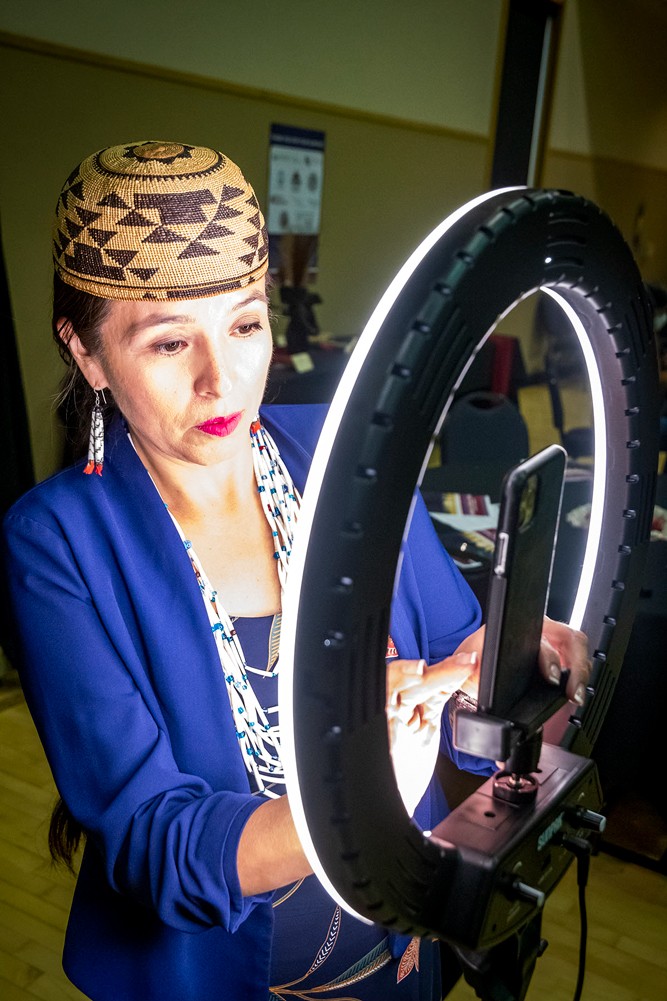
- Photo by Mark Larson
- Yurok Tribal Member Taralyn Ipiña, a chief operations officer for the Yurok Tribal Council, helps set up photo lighting in front of the "A Bleeding Moon" mural at the Yurok Tribe's MMIP summit on Oct. 4 at the Arcata Community Center.
When Native people find themselves in crisis, the same programs that often fail their non-Native counterparts are even less effective for them.
George said an important question to ask when someone is missing or murdered isn't just what happened, but "how many times could they have been made safe before they were taken?"
The sad truth, George said, is that the criminal justice system is often the only means for mental health intervention locally, where we have only a small mental health hospital with limited capacity and no facility prepared to treat dual diagnosis patients.
"It'll be the jail house that sees our loved ones last, not places that could have made them well," she said.
There's a dire need for culturally informed programs, said Morning Star Gali, a member of the Pit River Tribe and project director for Restoring Justice for Indigenous People. Tribal communities often don't have safe housing programs, leaving survivors of abuse to move to urban areas for safety. Some rehabilitation programs have proven effective for Native people, Gali said, but they don't always meet the criteria for billable services under MediCal and other programs.
Similarly, April McGill, a California Native woman who serves as the director of the community partnerships and projects for the California Consortium for Urban Indian Health, said lots of intervention models have proven successful with Native children and families, but they don't meet the Welfare and Institution codes needed to be court-mandated or to receive state and federal funding.
She said cultural practice is crucial to community, noting that children want a feeling of belonging, whether through hunting, fishing or dance.
"Our people need to know and feel they are connected and I think that once our young people are connected, we will see a decrease in our missing people, our murdered people, because we know our culture is prevention," McGill said, adding that cultural services are also needed in adulthood, with officials providing trauma-informed, culturally appropriate care and traditional healing practices. "Want to go to a talking circle? That's billable. You want to go to a sweat? That should be a billable service."
In the day's first panel, Abinanti stressed that it is Native people and programs that will break the now generations-long cycle of violence, victimization and trauma.
"We survived a horrible invasion with horrible behavior, and that was then and this is now," she said. "And the people who came here don't know how to act here. They've pretty much brought ruin to us in a couple hundred years, when for thousands of years we didn't do the damage they've done. So we need to back out, help them, and share with them our ways, because we do know how to behave here. And it's important that we take a lead to do this."
'Time is Lost'
A sad truth in Indian Country is that if you're violating the law, there are a host of agencies that can step in to enforce it, from the California Department of Fish and Wildlife and the FBI to tribal police and the sheriff's office.
"If you're doing something wrong, there's a lot of people who can catch you," George said. "But when you need help, they're often wondering who it is to help you."
Multiple panelists lamented the jurisdictional morass created by Public Law 280, which was passed by Congress in 1953 and granted states criminal jurisdiction over Native reservations. The result of the law is that full police powers are withheld from tribal police officers, and county sheriffs — often with sprawling, rural districts — are tasked with enforcing state laws on tribal lands.
This creates a host of problems, including confusion about jurisdictional boundaries to the point that when a tribal member is reported missing, there's often a dispute over which law enforcement agency has jurisdiction and should be the lead agency.
"Valuable time is lost when we're worrying about whose case it is," said George, echoing a concern voiced by many, including some who pointed out studies have shown the first 48 hours to be crucial in determining whether a homicide case will ultimately be solved.
But Yurok Tribal Police Chief Greg O'Rourke explained the issues created by Public Law 280 go well beyond disagreements over jurisdiction, saying they also impact his ability to retain quality officers and keep them safe in the field.
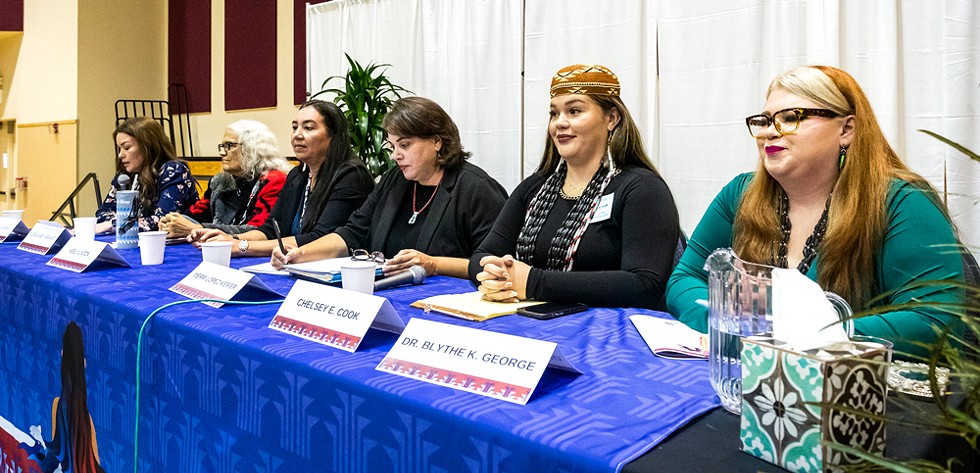
- Photo by Mark Larson
- From left: Moderator Jessica Carter and panelists Abby Abinanti, Keely Linton, Merri Lopez-Keifer, Chelsey Cook and Blythe George discuss MMIP and needed systems change during the Yurok Tribe's MMIP symposium Oct. 4.
Tribal police officers simply aren't treated as equal officers under the law, O'Rourke said, adding that they aren't afforded the protections of the state Peace Officers Bill of Rights, access to the statewide police union's legal defense fund or state pensions. Officers in museum and transit police departments get these things but not tribal officers, Yurok Tribal Prosecutor Rosemary Deck added, and O'Rourke said the dynamic turns his department into a training ground for state, county and city departments.
The disparity also keeps tribal officers from accessing state and national databases used to track everything from restraining orders to missing persons. Specifically, O'Rourke said tribal officers don't have access to the California Law Enforcement Telecommunications System, known as CLETS, which prevents them from uploading tribal court orders into the system — a potentially crucial step for protecting victims of domestic violence and other forms of abuse. CLETS is also an invaluable tool for officers in the field to access information about someone they are about to contact, helping them determine if the person is wanted, subject to a court order or on parole, among other things.
"All of these issues are compounded when someone calls law enforcement at 2 a.m.," O'Rourke said.
During brief remarks between panels, Humboldt County Sheriff William Honsal said CLETS access for tribal departments was an issue he intended to bring to the California State Sheriffs Association, saying the only way to address the MMIP epidemic — and public safety generally — is through partnerships.
Many of the issues underlying the MMIP crisis were brought into painful focus midday, when Judy and Gary Risling — parents of Emmilee Risling, who was reported missing in October of 2021 — addressed the symposium. They talked of the feeling of disconnect when their daughter — clearly in a worsening state of mental health crisis — would be picked up by police while walking naked only to have the police say they couldn't do anything because she wasn't a danger to herself or others, and give her some clothes and drop her at a friend's house.
"I feel walking naked is being a danger to yourself," Gary Risling said, saying the police ultimately did a disservice to her by not arresting her for indecent exposure, saying that would have provided the record needed to get a judge to take her case more seriously later on, underscoring George's point that the criminal justice system is often the only available mental health intervention. "It may be a nice thing [not to arrest her] but it's not the right thing."
Judy Risling noted that within days of a Humboldt County Superior Court judge ordering Emmilee released from jail with a promise to appear at a future court date, she "became an MMIP."
At one point, Gary Risling asked Christopher Lorenz, the special agent in charge of the Bureau of Indian Affairs' California justice services office, why the agency never helped search for his daughter. Lorenz said he could have provided resources but didn't have jurisdiction, as BIA was not asked to by the local sheriff. What if they'd found a body, Gary Risling asked.
"If you found a body and the sheriff asked me to help, I can help," Lorenz said, underscoring Public Law 280's effect.
Gary Risling closed by talking about a conversation he had with one of Emmilee's children, noting that "a piece of you dies" when you lose a child, but it's a trauma that will span generations.
"The thing that kills me the most is when your 10-year-old grandson says, 'Grandpa, can you take me down to look for my mom?'"
He said he replied that a lot of people were out looking.
"What happens if we don't find her?" he recalled the child asking.
"Well," he said, "we'll keep looking."
'Your Issue, As Well'
The day's final panel wasn't so much of a panel, but a roundtable discussion between tribal leaders, state Sen. Mike McGuire, state Assemblymember Jim Wood, North Coast Congressmember Jared Huffman and Fifth District Humboldt County Supervisor Steve Madrone. The white men said they were there to listen.
And after brief introductions, they did listen for more than an hour, as tribal leaders urged action on a spectrum of fronts. They praised recent laws instituting a feather alert system to spread word of missing Native people, and of an initiative to provide the Department of Justice funding to study and track MMIP cases. But much more is needed, they said. They asked for more funding for forensic testing, noting that when a bone is found on tribal lands, they sometimes can't pay for the testing to determine if it's from an animal or someone missing. They asked for changes to Public Law 280 to put more power — as well as funding and resources — in tribal hands. They asked for the creation of a MMIP law enforcement task force that could cross jurisdictional boundaries to deploy at a moment's notice when a report is received, and better systems to collect and share data on Native people. They asked for help creating mobile peer support teams to respond to folks in mental health crises, funding for dual treatment mental health centers, and more representation in local school curriculums.
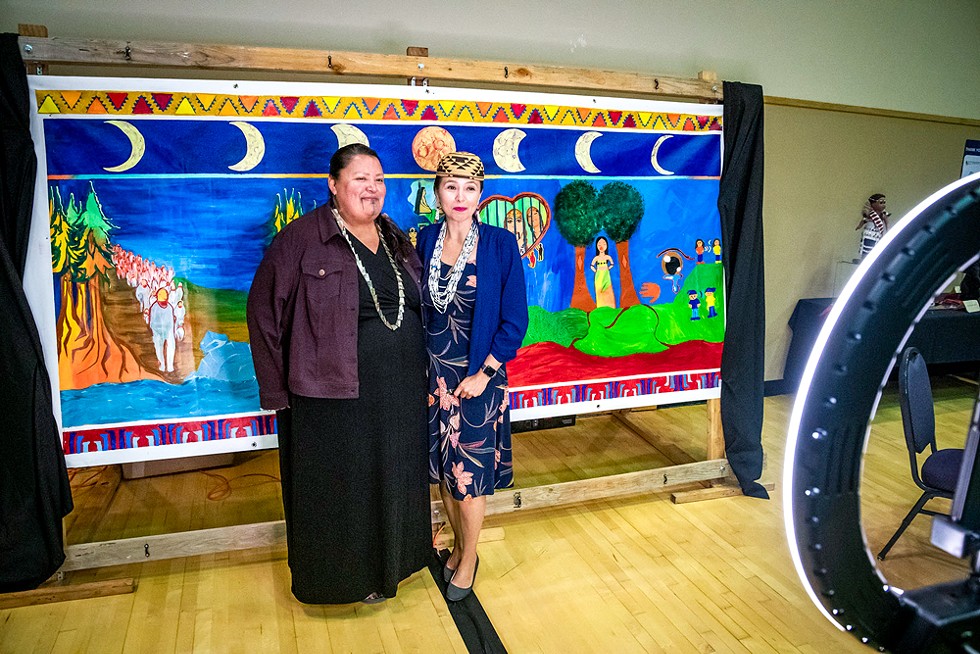
- Photo by Mark Larson
- Yurok Tribal Member Taralyn Ipiña (right), chief operations officer for the Yurok Tribal Council, poses for a photo with Pim Allen.
At one point, a tribal leader asked everyone in the room who'd had a loved one murdered or go missing to stand up. About a quarter of the room stood.
"Look how many people are standing," the leader implored the state, federal and county elected officials. "This is why everyone's here. This is what we need you for."
Speaking toward the day's end, after all his tribal counterparts had addressed the representatives gathered at the first-of-its kind summit, Yurok Tribal Vice Chair Frankie Myers noted the "sense of invisibility" Native people experience, of being undercounted or ignored, of seeing a local official use racist language toward Native people yet be allowed to retain his seat.
"I would ask that this be your issue, as well," Myers said. "What do we want? Legislation. Absolutely. But just bring the conversation to light ... I have to ask our representatives to do just that — represent us. Speak of us. Include us in the conversation."
Thadeus Greenson (he/him) is the news editor at the Journal. Reach him at (707) 442-1400, extension 321, or [email protected]. Follow him on Twitter @thadeusgreenson.

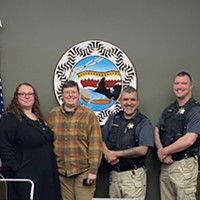
Comments